It’s the end of September and the garden is looking good after a week of really heavy rain in the first part of the month. It was the rain that puts a smile on gardeners faces and it fell mostly at night time with the daytime temperatures staying pleasantly warm.
Kourosh’s half price Maya the bee seeds are still attracting the bees.
In general the Cosmos are doing a lot to provide lots of colour at this time of year.
I lost my Heptacodium jasminoides last year and was quite shocked that it could have left me as I had bought it in 2007. However, last autumn I replaced it with the same species but called the alternative name Heptacodium micanioides. It has flowered in its first year with me so I should be happy but it does not seem to be quite the magnet that the other one was for the bees.
It’s flowers are still as beautiful and perfumed – it just has a bit of growing up to do.
On the right of the Heptacodium is one of my Sedums. I have several of these in the garden and they are excellent, colourful, easy plants to grow – only the bees are totally uninterested in them. Would someone please recommend a large Sedum that will attract the bees?
My next disappointment is on the left of the Sedum – a red Gaura (Siskiyou Pink). It just does not have the pull for the bees as my white ones.
Just comparative, the bees will still come and relieve the flowers of their pollen.
Enough complaining! I am still enchanted with my Flower of an Hour (Hibiscus trionum).
It looks good whether you view it from the front or from the back!
I don’t go too much for very fancy flowers and I think my sister notices this on her visits. Her tastes are more flamboyant and she tries to spice up the garden by tempting me with a new seed or plant. This Dahlia is from a packet of seeds she shared with me called “Yanky Doodle Dandy”. Actually some of them are not bad and they leave the centre open for the pollinators so I cannot complain.
The rain brought on a new flush of raspberries. I find these yellow Fallgold sweeter than the pink ones.
But for decoration or desserts the pink ones do look better on a plate.
The bees don’t seem to have a preference. They must produce tasty nectar as the flowers are visited every morning.
Kourosh has moved two of the hives further back in an attempt to take them more out of the sun. It is only a partial success as they are facing the morning sun. As you can see, the net is still being well used to trap the hornets. There is still no let up from their constant attack.
The scent of ivy flowers is ever present when we walk around here but we do not notice a lot of ivy pollen going into the hives. There is a lot of wild mustard flowers (Sinapis arvensis) around and some of the pollen matches that. The Ivy bee (Colletes hedera) gathers almost solely the ivy pollen. I saw this female at the same nest site as I had seen last year (https://beesinafrenchgarden.wordpress.com/2014/10/12/la-bourgade-revisited/). It is just as extensive as it was but not as busy. The whole area had been soaked by a week of heavy rain just at the time that the males would normally leaving the nests.
The heavy rain that brought relief to the garden and brought out the flowers in abundance was perhaps not so well timed for the Ivy bees.
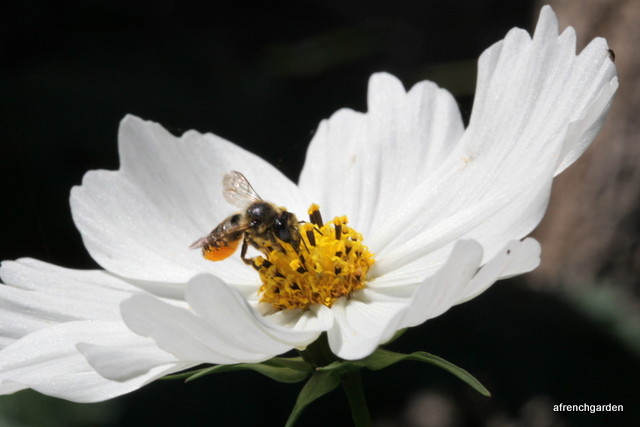
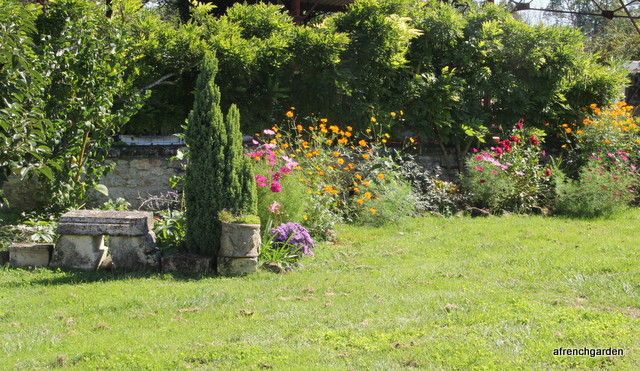
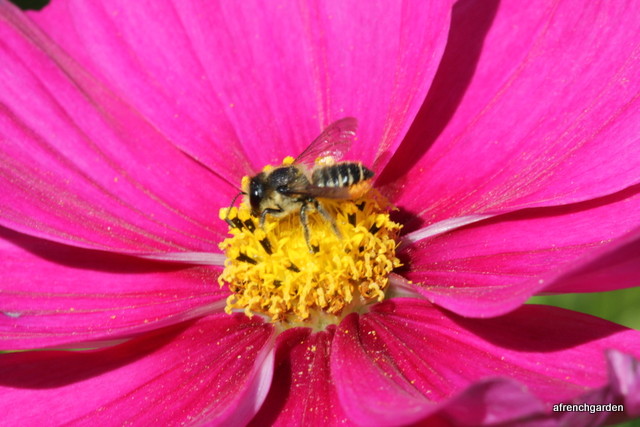
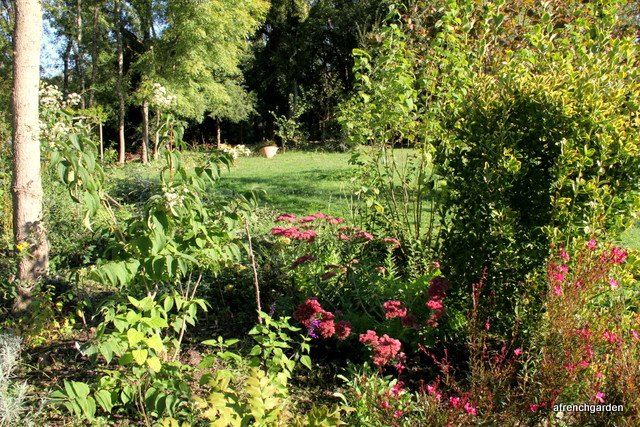
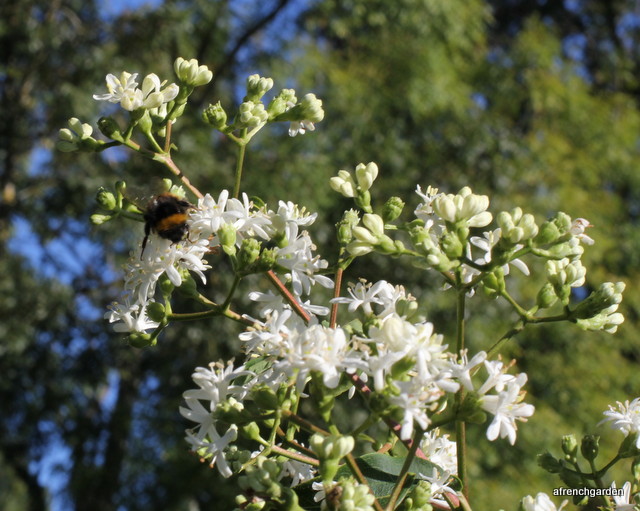
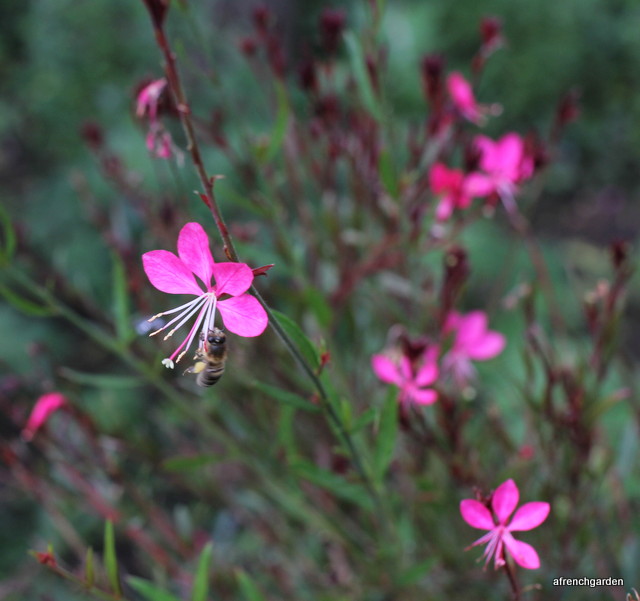

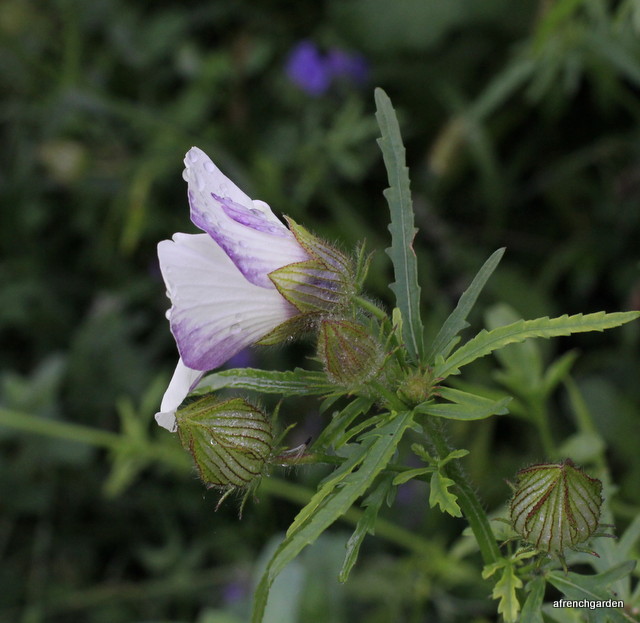
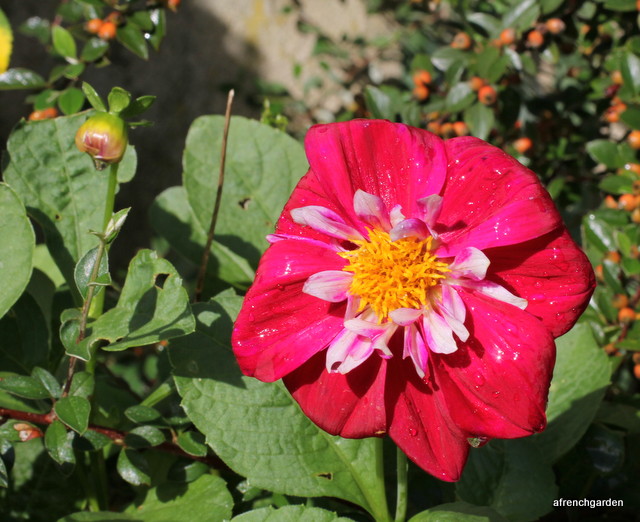
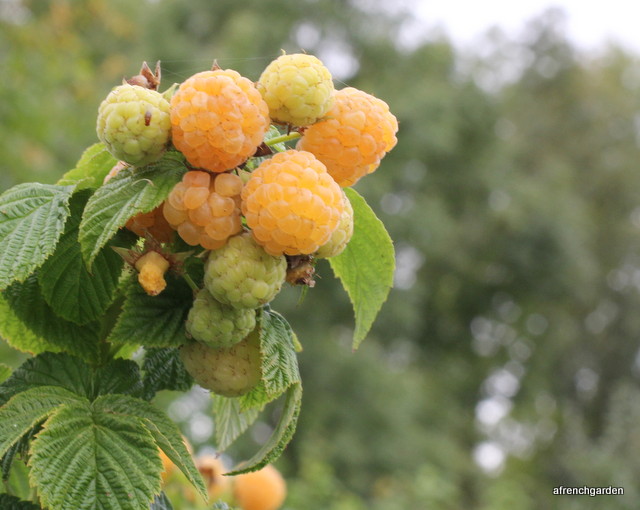


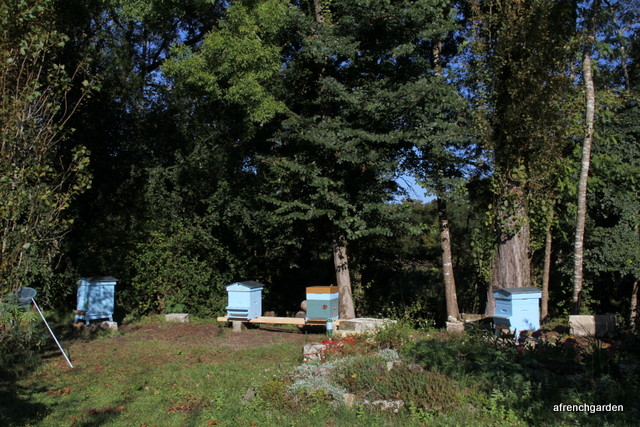
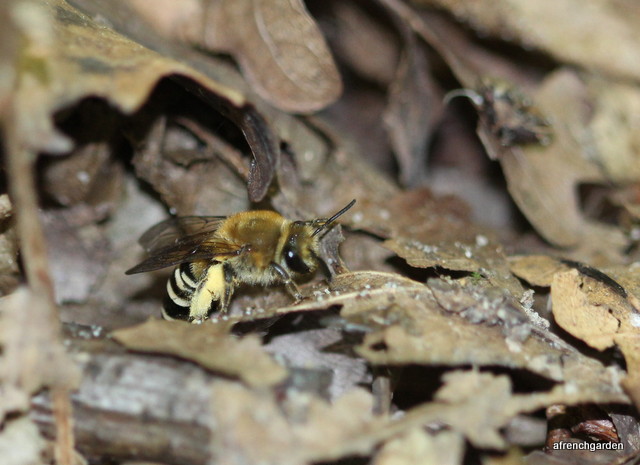
Very nice pics!!!
LikeLike
Thank you. We do not have any pigeons in the garden here but we do have a pair of collar doves that nest nearby and have claimed the garden and the birdseed. Amelia
LikeLike
Nice, I would love to have a garden cause with so many pigeons in an appartment things are becoming very difficult for me.
LikeLike
I can imagine that finding space for them in an apartment is difficult.
LikeLike
Heptacodium micanioides has been on my wish list for a while, yours looks so beautiful. Interesting comment about Gaura, I grow lots of G. lindheimeri and can’t report seeing one Bee or Hoverfly attracted to them. I had been feeling I’d made a mistake planting so many (I grew them all from seed). I’ve been looking here for Ivy Bees and haven’t seen any at all, although I have seen what I think were digger wasps drinking rain drops from the surface of the flower heads.
LikeLike
Go for the Heptacodium it has an attractive bark as well as the scented flowers. I do not think that solitary bees are as interested in the Gaura as the honey bees are. The honey bees arrive in the morning and strip the stamens of their pollen. I think the Ivy bees could be limited to areas with sandy soil where they can nest so it might depend on the soil near you. They are really beautiful bees. Amelia
LikeLiked by 1 person
Thanks Amelia, I’ve cleared a space today and am going to find one for my garden.
LikeLiked by 1 person
We’ve been very dry here all summer but the wild flowers have held up well and the bees are out in force. Asters and goldenrods seem to attract them more than others.
LikeLike
It is funny how I only lately made the connection (through your blog) of the name of the group of Asters known as New England Asters. Amelia
LikeLike
Most envious of your autumn rain Amelia. Our spring has delivered only half the average so far. I will check in autumn, but I recall five or six bees at least across Sedum “Autumn Joy” blooms. I think the un-named paler pink one is also bee attracting.
LikeLike
It looks as if “Autumn Joy” is in the Specabile group which is good for pollinators, so thank you for your recommendation, I think mine are from the wrong group. Amelia
LikeLike
Well done with the raspberries. Our Fallgold were knocked back during the canicule and have provided a very poor crop this year.
LikeLike
Raspberries are not really the fruit to be growing in hot dry areas – they prefer Scotland! Still we get enough to give us a bit of variety. Amelia
LikeLike
It is very strange that your bees don’t like your Sedum, mine are covered in bees all day, I have mainly Matrona and Purple Emperor, both grow large. It is wonderful to have some rain to bring the garden back to life after such a hot summer. The last week has been quite cool in the mornings and at night and today it’s raining again with the forecast telling us that it will rain for the next 3 days.
LikeLike
If you see Susan’s comment I think she has solved my problem. You might enjoy the link too and it recommends your Matrona as being good for insects. I will be very careful when replacing my Sedums. Thanks for the tip for Matrona. Amelia
LikeLiked by 1 person
This may help with your sedum selection: RHS Sedum Trials.
LikeLike
That is a really good link for me as I do like Sedums and wanted to know more about them. I think you could have solved the enigma as it says, “Sedum ‘Herbstfreude’ is probably the best known and most widely grown of all the herbaceous sedums” then later under the “Wildlife” heading ” Unfortunately, the very popular S. ‘Herbstfreude’(as well as closely related cultivars) was amongst the poorest for attracting insects as it has only small petals and lacks stamens.” I’ve had my Sedums for some time and they are all babies of the original as it is very pretty but of unkown origin. I will get some S. spectabile and replace them this year. Thank you. Amelia
LikeLike
You seem to have had lots of responses to your sedum question but here’s one more. Tish doesn’t mention which sedum she grows but the bees love it. http://tishfarrell.com/2015/09/30/autumn-in-my-garden/#comments
LikeLike
I’ve had a look and that is just what I would like. I have told her I am very jealous! Amelia
LikeLiked by 1 person
🙂
LikeLike
Wow lots of hives now, has K made them all?
LikeLike
All the hives have been bought. I think it would probably be a lot more expensive if you had to buy the wood and make them yourself. The beautiful blue paint job is my handwork. Amelia
LikeLike
I always want my hives to be in the sun as much as possible! Morning sun especially is great. But I appreciate your sun is rather fiercer than ours.
LikeLike
We take “L’Abeille de France & l’apiculteur” which is equivalent to your “BeeCraft” magazine and in the section dedicated to new beekeepers it noted that a hive kept in the full sun produced 25% less honey. Of course, this is written for French readers, as you say, this might not be the case in the U.K. Ours don’t get the sun all day. A bit of sun playing on their front boards first thing in the morning would seem ideal. Wouldn’t mind a balcony with warm early morning sun myself. Amelia
LikeLike
We have a sedum called Autumn Joy which the bees and pollinators all enjoy. Perhaps it depends if there something else in flower they prefer?
I think I might give the yellow raspberries a go.
LikeLike
Autumn Joy is on my “wish list”as a definite. I would also like to get some of the smaller ones to stick in rockeries, Sedum Kamtschaticum is recommended by the RHS. Amelia
LikeLike
When we realized how much the bees liked the sedum, we bought some Autumn Joy. While my wife was carrying the plants out to the garden from the car, bees were already landing on the flowers. Around here they love ’em, but so do the deer. Last year I sprayed a milk mixture (8 parts water, 1 part milk) around the plants which proved to be effective, but not this year. You’re lucky, your deer don’t bother your garden. 🙂
LikeLike
One of my projects is to get some more sedums into the garden. I will be on the look out for Autumn Joy – a spectablis variety. I must admit I can get a bit miffed when slugs and snails attack a favourite plant but the damage can’t be on the same scale as a grazing deer! We are lucky ours pass us by. Amelia
LikeLiked by 1 person
Glad to see your ivy bees are still there, I have also noticed variability in the nest site activity here in Devon.
LikeLike
That’s interesting, you’ve been getting more rain that usual too. Perhaps the wet soil is not ideal for them. Amelia
LikeLike
Pingback: In a Vase on Monday – Hidden Scent and Plants for Bees | Gardening Jules
Lord, those raspberries look good! Re your comments about snails on dahlias – now we do indeed have them – lots of tiny ones to pick off and throw over the fence (not really). RH
LikeLike
I’ve just discovered some little snails in my dahlias. Either it depends on the amount of rain you receive or you’ve been throwing yours over my fence.
LikeLiked by 1 person
I have a large sedum that is always crawling with bees. Sadly I don’t know it’s name as it was here before me.
LikeLike
I planted mine in the hope that it would be like that with butterflies and bees. Ah well, now I know – better late than never. Amelia
LikeLiked by 1 person
How wonderful to have bees buzzing about! Your garden always inspires me and the very least makes me take in a healthy deep sigh. Thank you for sharing your beauty… Have a lovely day, Koko❀
LikeLike
Thank you. The bees are very special to me. They make the garden so much more alive and it makes having flowers so much more worthwhile when they are appreciated by so many other creatures. Amelia
LikeLiked by 1 person
I very much agree! 🙂
LikeLiked by 1 person
Hello Amelia,
The garden is looking great, and as always lots of bees around your flowers. I’ve looked at the Sedum replies, and I would concur that we have tried several named Sedums. Many look lovely with maroon or darker flowers and foliage. But the insects largely ignore the flowers. S. spectabile ‘Autumn Joy’ on the other hand ( or as it is apparetnly more correctly known – Herbstfreude, being a sterile German origin hybrid), is THE insect friendly flower in our garden – honeybees. bumbles, butterflies, moths …you name it, they all visit it. The only flower that seems to close with us for pan- insect appeal is Buddliea, but with us honeybees don’t visit this very much. The other great thing with Autumn Joy/herbstfreude is that the colour intensifies from pale pink – when its at its best as a nectar source, to intense deep claret as the flowers age. And being sterile it lasts for ages. So if you can find some, I’m sure all K’s bees will flock to it – but also plant it en masse for even better results.
BW
Julian
LikeLike
Autumn Joy is on my shopping list for the next time I am in the U.K. I think for bees it is a good general idea to plant on mass to attract them. It is not only for the honey bees as I have memories of the sedum in my parents garden being covered with butterflies. I don’t see any aggression between the bees on the plants. They can be clumsy and knock into each other but the only ones that have a hard time are the females being targeted by their males on favoured nectar plants. Amelia
LikeLiked by 1 person